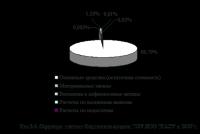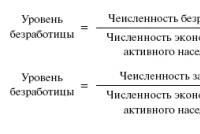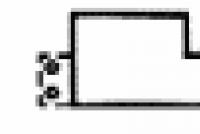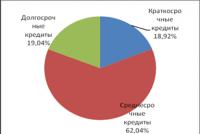Organization's environmental tax. Calculation of tax, rates, accounting. What are the deadlines for submitting payments for negative environmental impact to Rosprirodnadzor, the deadlines for making these payments to the budget, as well as the deadlines for submitting reports on
An example of calculating payment for environmental pollution. it is about paying for garbage. The organization has a rented office. she is not involved in production. does not set any limits.
In this situation, the size of the fee will be determined using the formula given in the article. The amount of payment must be calculated as follows: P \u003d 248.4 rubles / t * amount of garbage (in tons) * 0.3 * 1.6 * 2.2 * 5.
The rationale for this position is given below in the materials of the "Glavbukh Systems"
1. Article:We calculate and make environmental payments
Calculating the amount of fees for solid waste
The fee is calculated using the following formula:
P \u003d N? M? Kp? Ki,
where P - the amount of payment for environmental pollution; M - the amount of garbage for reporting period; H - standard of payment for waste by hazard classes; Kp - coefficient taking into account the soil condition of the economic region in which the company is located; Key - indexation coefficient. *
It should be noted that the standard payment for waste hazard classes is specified in the RF Government Decree No. 344 of June 12, 2003. There are five waste hazard classes (I class - extremely hazardous, V class - practically non-hazardous). The belonging of a company's waste to a certain class can be determined by the Federal Classification Catalog of Wastes. It was approved by order of the Ministry of Natural Resources of the Russian Federation of December 2, 2002, No. 786. In this catalog, each type of waste is assigned a thirteen-digit code, the last digit of which just means the hazard class. For example, unsorted garbage from household premises of organizations, excluding large-sized ones, is IV hazard class, and garbage from cleaning the territory and premises - V.
The coefficient Kp, taking into account the condition of the soil, is also in the decree No. 344.
For 2008, two indexation coefficients have been established: 1.48 and 1.21 (clause 3 of article 3 of the Federal Law of July 24, 2007 No. 198-FZ "On the federal budget for 2008 and for the planning period of 2009 and 2010" ). The first applies in relation to the 2003 regulation. And the second - in relation to the 2005 standards.
Waste is usually measured in cubic meters, and in order to convert it to weight units, you need to know the density of the waste. This information can be obtained from the limits of the enterprise or use special literature.
Example 1
The trade organization received permission from Rostekhnadzor for the disposal of solid household waste. Let's assume that for the 1st quarter of 2008 the actual amount of household waste was 0.3 tons within the established limit. This type of waste belongs to the IV hazard class. Therefore, in accordance with Appendix No. 1 to Resolution No. 344, the payment standard is 248.4 rubles / ton. The organization operates in the Central Economic Region, therefore the multiplying coefficient, according to Appendix No. 2 to Resolution No. 344, is 1.6. The indexation coefficient in this case will be equal to 1.48 (since we use the 2003 standards when calculating the fee).
Thus, the amount of payment for the disposal of municipal solid waste will be:
248.4 rub / t? 0.3 t? 1.6? 1.48 \u003d 176.46 rubles *
Please note: the pollution charge over the limit is additionally multiplied by 5. *
I.A. Evstratova, Chief Accountant of Harvest LLC
2. DECISION OF THE GOVERNMENT OF THE RUSSIAN FEDERATION No. 344 of 12.06.2003 "On the standards of payment for emissions of pollutants into the air from stationary and mobile sources, discharges of pollutants into surface and underground water bodies, waste disposal". .. (modified as of January 8, 2009)
Waste disposal fees
production and consumption
| (rubles) | ||||||
| Waste type (by hazard classes for the environment) |
Unit measurements |
Payment standards for placement of 1 unit measuring waste in limits established placement limits waste * |
||||
| 1. | Waste of I hazard class (extremely dangerous) |
ton | 1739,2 | |||
| 2. | Waste hazard class II (highly hazardous) |
ton | 745,4 | |||
| 3. | Waste of III hazard class (moderately dangerous) |
ton | 497 | |||
| 4. | Waste of IV hazard class (low hazard) |
ton | 248,4* | |||
| 5. | Wastes of V hazard class (practically non-hazardous): |
|||||
| extractive industries | ton | 0,4 | ||||
| processing industry | ton | 15 | ||||
| others | ton | 8 | ||||
| (as amended by the Government Decree on July 20, 2005) Russian Federation dated July 1, 2005 N 410, - see the previous edition) | ||||||
* The rates of payment for the placement of production and consumption waste within the established limits are applied using: a coefficient of 0.3 for waste disposal at specialized landfills and industrial sites equipped in accordance with the established requirements and located within the industrial zone of a source of negative impact; * coefficient 0 when disposing in accordance with the established requirements of waste subject to temporary accumulation and actually used (disposed of) within 3 years from the date of placement in own production in accordance with the technological regulations or transferred for use during this period.
Appendix N 2
to the government decree
Russian Federation
dated June 12, 2003 N 344
Article 15 of the Federal Law of 23.12.2003 N 186-FZ "On the federal budget for 2004" establishes that the rates of payment for negative impact on environmentin force in 2003 are applied in 2004 with a factor of 1.1.
- Note from the manufacturer of the database.
Environmental factors
(condition of atmospheric air and soil), by territory
economic regions of the Russian Federation
| Economic regions Russian Federation |
Coefficient value | |||
| for atmospheric air * |
for soil ** | |||
| Northern | 1,4 | 1,4 | ||
| Northwestern | 1,5 | 1,3 | ||
| Central | 1,9 | 1,6* | ||
| Volgo-Vyatsky | 1,1 | 1,5 | ||
| Central Black Earth | 1,5 | 2 | ||
| Volzhsky | 1,9 | 1,9 | ||
| North Caucasian | 1,6 | 1,9 | ||
| Ural | 2 | 1,7 | ||
| West Siberian | 1,2 | 1,2 | ||
| East Siberian | 1,4 | 1,1 | ||
| Far Eastern | 1 | 1,1 | ||
| Kaliningrad region | 1,5 | 1,3 | ||
* It is applied with an additional coefficient of 1.2 for the emission of pollutants into the atmospheric air of cities. ** It is applied when determining the payment for the disposal of production and consumption waste.
3. References:Indexation coefficients of payments for environmental pollution
Environmental payments (also called payments for negative impact on the environment - NVOS) are established by the current legislation. The main document regulating the nature protection area is Federal Law No. 7-FZ dated 10.01.2002. It stipulates the obligation for all enterprises that have a negative impact on the environment, to provide annually the calculation of fees for the IEE and the implementation of corresponding payments to the budget. This requirement is mandatory for any organizations whose work is associated with the following options for environmental pollution:
- disposal of waste generated at the enterprise in the course of production activities;
- emissions of harmful substances into the atmosphere;
- discharges in the form of runoffs of pollutants into water bodies.
The calculation of the fee for the IEE in 2016 is quite different from that carried out in the previous calendar years. The reason for this is the changes in legislation that have come into force that regulate the scope of activities of enterprises that have a negative impact on the environment. They will affect all organizations whose activities are associated with a negative impact on the environment and are regulated by Federal Law No. 7-FZ of 10.01.2002.
Changes to the calculation of the fee for the NVOS, which entered into force in 2016
The amendments made to the current legislation affected two main points at once regarding the calculation of fees for the IEE:

- the second most important point, which is presumably to seriously change the calculation methodology, is the entry into force of the RF Government Decree No. 913 dated 09/13/2016. It contains the rates that will be used in calculating the fee for NVOS in 2016-2018. In addition, this document contains a new additional indexation coefficient, the size of which will be 2 from 01.01.2016.
Obviously, quite serious changes are being made regarding the calculation of fees for the IEE, which came into force in 2016. In addition, a certain concern of entrepreneurs-payers of the NVOS is caused by the fact that there is still no complete clarity, both in the form of the declaration that must be submitted and in the final calculation method. The situation is somewhat reassured by the fact that the deadlines for submitting a declaration of payment for NVOS for 2016 are quite sparing - no later than 03/10/2017, while payment in accordance with the data specified in the report must be made before 01/10/2017.
Composition of the declaration for the calculation of fees for NVOS
In the above-mentioned draft Order of the Ministry of Natural Resources, the following composition of the declaration for payment for NVOS is assumed:
- calculation of the total amount of payment, including a breakdown for each type of impact;
- calculation of the amount of payment separately for each source of pollution or for a separate territorial subdivision of the paying company;
- calculation of the initial payment base;
- calculation of funds directed to the implementation of measures for the protection of nature, with confirmation of their development;
- payment documents that confirm the payment to the budget.
There are currently no approved forms of the above calculations. Even the above form of the title page of the declaration has the status of a draft, which, possibly, will be finalized and only after that approved.
At the same time, the main principles for calculating the fee for the NVOS in 2016, according to experts working on the development and approval of the documents under consideration, will remain unchanged. Therefore, it would be quite logical to consider them in more detail.
Rules for calculating fees for NVOS
Prior to the amendments that came into force in 2016, the calculation of the fee for the IEE consisted of the following parts:
- title page and calculating the size of the fee for the IEE to be transferred to the budget;
- sections 1, 3 and 4, containing calculations for each type of pollution (Section 2 has not been compiled since 01.01.2015; earlier it contained data on emissions of harmful substances into the atmosphere by mobile objects).
Title page and calculation of the total fee for the NVOS
Filling out the title page and calculating the total payment for the NVOS to the budget is not particularly difficult. Basically, for this, information is used from the statutory documents, various certificates of registration and registration of the paying organization, as well as data from the corresponding sections of the calculation. They are simply summed up to obtain the amount of the NWOS payment to the budget.
Forms of documents for the title page of the calculation (valid until 2016), the calculation of the payment to the budget and the corresponding sections of the calculation can be found in a special section of the official website of Rosprirodnadzor, on the website of any of its territorial bodies or various information portals.
Samples of completed documents with some tips to facilitate the procedure are as follows:

It is quite possible that in the final version of the Order of the Ministry of Natural Resources, changes will be made not only to the title page and its name, but also to the calculation of the fee for NVOS in 2016 to the budget.
Sections 1, 3 and 4 of the tax declaration
The basic calculations of the fee for the IEE are contained in these sections of the submitted declaration. They are carried out on the basis of the same principles. Each section consists of an information and calculation part.
The first contains information on the permit for emissions, effluents or waste disposal of the production activities of the paying company, as well as basic data on the source of pollution or the waste disposal facility.
The second part of each of the above sections contains the calculation of the fee for the IEE for the corresponding type of pollution. The procedure for performing the calculation is spelled out in the corresponding Order of Rostekhnadzor No. 204 dated 05.04.2007. Information on the rates of fees for the NVOS for 2016, as well as the indices used in the calculations, is contained in the already mentioned Decree No. 913 of 13.09.2016.
The basis for the calculation is the rates of payment for the IEE for each individual type or source of pollution for 2016-2018 and the data of accounting and analytical accounting, which must be kept by the paying organizations.
The mechanism for taking into account the territorial features of the location of enterprises that have a negative impact on the environment, as well as the amount of payment in case of exceeding the standards for emissions, effluents or waste disposal limits established for the organization, is also contained in the Resolution No. 913 of 13.09.2016.
The calculation methodology that existed before the latest amendments to the legislation was quite complex. Therefore, in the overwhelming majority of cases, accountants or other employees responsible for performing the calculations of payments for the IEE and completing the corresponding reports used various auxiliary software products.
One of the most popular programs is considered to be the "Environmental Management Module", developed directly by employees of Rosprirodnadzor and located in the corresponding section of its official website. In addition, a fairly large number of service products are developed by specialized companies, for example, this one.
An example of calculating the fee for NVOS, performed using the appropriate software product, is shown in the video:
Conclusion
The calculation of fees for NVOS in 2016 will take place in accordance with the new regulations adopted during 2015-2016. The main change is the need to fill out a declaration for calculating the fee for the IEE. In this case, it is advisable to use auxiliary software products developed by employees of Rosprirodnadzor or specialized information companies.
Calculation of payments for pollution of the environment 2018-2019 is a procedure that is mandatory for persons making such payments. How to calculate the amount to be paid? How to calculate the base for pollutants, determine the rate, coefficient and deductions? What form is used for reporting in 2019, where to submit it and when? Consider the answers to these and other questions in the material below.
Calculation of pollution charges: basic principles and regulation
Calculation of payments for environmental pollution is regulated by the Law "On Environmental Protection" dated 10.01.2002 No. 7-FZ, which has been repeatedly updated. Payments for causing harm to the environment must be transferred to the budget (Article 16.4 of Law No. 7-FZ):
- small and medium-sized businesses - at a time in the amount for reporting year before March 1 of the year following the corresponding reporting year;
- other payers - based on the results of the 1st, 2nd and 3rd quarters by the 20th of the following months in the form of advance payments in an amount equal to 25% of the total payment for last year, as well as based on the results of the 4th quarter - until March 1 of the next year after the reporting year in an amount that is the difference between the calculated as a whole for the reporting year and advance payments.
NOTE! These payments are not collected in accordance with the rules of the Tax Code of the Russian Federation, so they are not subject to the postponement rule for a situation where the last day of payment falls on a weekend.
Read about what BCC values \u200b\u200bmay be present in payment documents and what they depend on, in the material "KBK on negative impact on the environment" .
The procedure for calculating payments for harm to the environment is enshrined in the provisions of Art. 16.3 of Law No. 7-FZ, other corresponding articles of the specified normative legal act (NLA), as well as bylaws.
In accordance with paragraph 1 of Art. 16.3 of Law No. 7-FZ, Russian firms and individual entrepreneurs are obliged to calculate payments for harm to the environment independently, using:
- data reflecting the size of the payment base for a particular polluting chemical substance (or waste);
- rates determined for payment for environmental pollution;
- coefficients established by law.
Having calculated the payment for harm to the environment for each of the pollutants or wastes (using rates and coefficients), the company must summarize the obtained figures and thus obtain the final amount of the considered payment to be transferred to the budget of the Russian Federation.
Environmental fees and environmental fees: who pays them
Payment for harm to the environment should be distinguished from the environmental fee, the calculation and payment of which is regulated by Art. 24.5 of the Law "On Production Wastes" dated June 24, 1998 No. 89-FZ. The fact is that the payment for harm to the environment, established in 2002, was quite often unofficially referred to as an environmental fee. However, as soon as Art. 24.5 of Law No. 89-FZ was put into effect (in December 2014), such an identification became incorrect.
Only manufacturers and importers of products and packaging for them, which must be disposed of after they have lost their consumer properties, are obliged to pay the environmental fee.
At the same time, payment for harm to the environment is regulated by a completely different legal regulation (Law No. 7-FZ) and is established for other payers (those who produce emissions and discharges into the environment of various pollutants and garbage, and also dispose of production waste).
Thus, the environmental fee:
- paid for recycled goods and packaging (issued by the payer or imported);
- governed by the provisions of Law No. 89-FZ;
- as a legal category has existed in the Russian Federation since December 2014.
And the fee, which is a fee for causing harm to the environment:
- paid for emissions and discharges of harmful chemicals and garbage, as well as waste disposal;
- regulated by the provisions of Law No. 7-FZ (and in terms of waste disposal - by some provisions of Law No. 89-FZ);
- as a legal category has existed since 2002 (note that a similar in legal form fee - in the form of payment for environmental pollution, waste disposal and other harmful effects, was levied before the repeal in 2002 of the RSFSR Law "On Environmental Protection" dated 19.12.1991 No. 2060-1).
The procedure for calculating payments for causing harm to the environment in force in 2018-2019 contains the decree of the Government of the Russian Federation of 03.03.2017 No. 255.
For more information about the period for which this document is valid, read the article "The Rules for Calculation and Collection of Fees for Negative Impact on the Environment were approved" .
How to calculate the payment base for pollutants and waste
In accordance with paragraph 1 of Art. 16.2 of Law No. 7-FZ, the payment base for substances and wastes corresponds to their volume (or mass) released into the environment during the reporting period. The size of the base is determined by the payer in the order of environmental control (clause 2 of article 16.2 of Law No. 7-FZ). The types of pollution that fall under the fee are (Article 16 of Law No. 7-FZ):
- emissions from stationary sources;
- discharges into water bodies;
- storage and disposal of waste.
When calculating the base in question, the following are taken into account (clause 4 of Article 16.2 of Law No. 7-FZ):
- standards of permissible pollution;
- standards for temporarily permitted pollution, as well as emissions and discharges that exceed them (including for emergency reasons);
- limits on the placement of pollution and their excess.
In accordance with the provisions of Resolution No. 255:
- emission standards and limits should be calculated separately for each production facility from which emissions are carried out (these standards can be found by contacting Rosprirodnadzor);
- the enterprise must independently (or with the involvement of experts) calculate the actual volumes of emissions and correlate them with the standards;
- the amount of the fee may be reduced due to:
- deductions representing the sum of the costs of reducing the polluting impact on the environment;
- applying incentive coefficients to the rates of the fee.
The collection is calculated by adding:
- products of indicators of standards and the established rate for them;
- products of emission indicators in excess of the standards and the established rate for them.
In some cases, time standards - limits are also taken into account. The product of the indicators of their actual value, its excess and the corresponding rates is added to the amount according to the usual standards.
If the payer is engaged in waste disposal and belongs to the category of large business, then in order to obtain standards, he must submit a waste disposal project to Rosprirodnadzor (clause 4 of article 18 of Law No. 89-FZ, guidelines approved by order of the Ministry of Natural Resources of Russia dated 05.08.2014 No. ). Small and medium-sized businesses that dispose of waste do not have to develop appropriate projects - they just need to report to the department on activities accompanied by the release of harmful substances into the environment (clause 7 of article 18 of Law No. 89-FZ).
If a company or individual entrepreneur generates waste of 1-4 hazard classes, passports must be drawn up for them (clause 3 of article 14 of Law No. 89-FZ). They must be kept in the payer's archive. Certified copies of such passports with documents confirming the hazard class of the emitted substances are sent to Rosprirodnadzor (clause 7 of the rules established by RF Government Decree No. 712 of August 16, 2013).
How to Determine Payment Rates for Environmental Damage
The rates in question, as well as additional coefficients for them, are established by separate legal acts of the Government of the Russian Federation (clause 4 of article 16.3 of Law No. 7-FZ). For application in the period 2016-2018, the rates are given in the Government Decree of 13.09.2016 No. 913. In 2019, the rates set for 2018 are applied with a coefficient of 1.04 (Government Decree of 29.06.2018 No. 758).
How to determine the coefficients for calculating payments for environmental damage
In order to calculate fees for environmental damage within the meaning of the provisions of Art. 16.3 of Law No. 7-FZ, the following coefficients are supposed to be applied:
- additional, which are defined in paragraph 3 of Art. 16.3 of the Law No. 7-FZ for special zones and when flaring (dispersing) associated gas;
- established by clause 6 of Art. 16.3 of Law No. 7-FZ, depending on the hazard class.
The current values \u200b\u200bof the coefficients can be found in the Decree of the Government of the Russian Federation of 03.03.2017 No. 255.
Calculation of payments for harm to the environment: deductions
In accordance with paragraph 11 of Art. 16.3 of Law No. 7-FZ, payments reflecting the costs of the payer for measures aimed at reducing harmful effects on the environment are deducted from the amount of payments for negative impact on the environment - separately for each pollutant or type of production waste within the reporting period. The associated costs must be documented.
Form for calculating the environmental fee (payment for environmental damage)
Since 2010, the agency that administers environmental payments is Rosprirodnadzor. Law No. 7-FZ establishes the obligation of payers to submit to this authority a declaration of payment for environmental damage (clause 5 of Art. 16.2, clause 4 of Art. 16.4 of Law No. 7-FZ). The deadline for its submission expires on March 10 of the year following the reporting year. That is, for 2018 the declaration must be submitted to Rosprirodnadzor no later than 03/08/2019, because 03/10/2019 - day off.
This document fixes not only the size of the bases and the amounts of payments calculated from them for each type of pollution, but also the total amount of payments accrued for the year, advances paid on them and the amount of the final payment for the year, taking into account the advance payments made during the year (letter from Rosprirodnadzor " On payment for negative impact ... "dated 11.04.2016 No. AS-06-01-36 / 6155).
Read more about submitting a declaration in the article "How to submit a declaration of payment for negative impact on the environment?" .
see also "Rosprirodnazdzor offered applications for offset and refund of payments for negative impact on the environment" .
Outcome
In 2018-2019, Russia has new rates for calculating payments for harm to the environment. There are no changes in the procedure for calculating payments and the timing of their introduction into the budget. The form of the calculation being created and the methods of submitting it to Rosprirodnadzor are also saved.
On December 21, 2015, the State Duma of the Federal Assembly of the Russian Federation adopted the Federal Law “On Amendments to the Federal Law“ On Environmental Protection ”and Certain Legislative Acts of the Russian Federation”. The law determines how impact fees will be charged in 2016.
The main provisions of the Federal Law:
- date changed, before the onset of which it is necessary to collect, transport, process, dispose of waste of I - IV hazard classes until July 1, 2016.
- introduced coefficient 0.3 when disposing of production and consumption waste that was formed in their own production, within the established limits for their placement at waste disposal facilities owned legal entity or individual entrepreneur on the basis of ownership, or other legal basis and equipped in accordance with the established requirements
- installed quarterly advance payments (except for the fourth quarter) fees for NVOS; payments are made no later than the 20th day of the month following the last month of the corresponding quarter of the current reporting period, in the amount of one fourth of the amount of the fee for negative environmental impact paid for the previous year. This provision does not apply to small and medium-sized businesses.
The fee for negative impact in 2016 must be paid:
For the 1st quarter of 2016 until April 20, 2016
Q2 2016 until July 20, 2016 in the amount of one fourth of the amount of payment for the negative impact on the environment, paid in 2015
Q3 2016 until October 20, 2016 in the amount of one fourth of the amount of payment for the negative impact on the environment, paid in 2015
For the 4th quarter of 2016 until March 1, 2017 in the amount of one fourth of the amount of payment for the negative impact on the environment, paid in 2015
In this case, the declaration of payment for the NVOS for 2016 must be submitted before March 10, 2017
Please repost our material:
Sp-force-hide (display: none;) .sp-form (display: block; background: # 1b2a4b; padding: 20px; width: 100%; max-width: 100%; border-radius: 5px; -moz- border-radius: 5px; -webkit-border-radius: 5px; border-color: # 000000; border-style: solid; border-width: 1px; font-family: Arial, "Helvetica Neue", sans-serif;) .sp-form-fields-wrapper (margin: 0 auto; width: 690px;) .sp-form .sp-form-control (background: rgba (255, 255, 255, 1); border-color: rgba (0 , 0, 0, 1); border-style: solid; border-width: 1px; font-size: 15px; padding-left: 8.75px; padding-right: 8.75px; border-radius: 4px; -moz-border -radius: 4px; -webkit-border-radius: 4px; height: 35px; width: 100%;) .sp-form .sp-field label (color: rgba (255, 255, 255, 1); font-size : 13px; font-style: normal; font-weight: bold;) .sp-form .sp-button (border-radius: 4px; -moz-border-radius: 4px; -webkit-border-radius: 4px; background -color: # 00cd66; color: #ffffff; width: 100%; font-weight: bold; font-style: normal; font-family: Arial, "Helvetica Neue", sans-serif; box-shadow: none; - moz-box-shadow: none; -webkit-box-shadow: none;). sp-form .sp-button-container (text-align: left; width: 100%;)
Calculation form the amount of the environmental fee is approved by order of the Federal Service for Supervision in the Sphere of Natural Resources No. 488 of August 22, 2016 « On the approval of the form for calculating the amount of environmental fees "(Registered by the Ministry of Justice of Russia on 10.10.2016 No. 43974). You can read the order and download the form for calculating the environmental fee bylink.
The form has two sections:
- section 1 " General information about the manufacturer, importer of finished goods, including packaging of such goods ”;
- section 2 " Calculation of the amount of environmental fee».
The environmental fee is an independent non-tax payment defined by Article 24.5 of the Law of 24.06.1998 No. 89-FZ (letter of the Ministry of Finance of Russia dated 13.04.2015 No. 03-02-07 / 1/20823). The environmental fee has nothing to do with payment for environmental pollution.
Settlement deadline
It is necessary to pay the environmental fee for 2016 and for the first time submit a calculation according to the approved form by April 15, 2017. The calculation will need to attach copies of payment documents for payment. The calculation of the environmental fee will need to be submitted to territorial body Federal Service for Supervision of Natural Resources.
It is not necessary to submit a calculation of the environmental fee in the form approved by order No. 488 dated August 22, 2016 for the past periods. Accordingly, you will not need to submit the calculation in 2016.
Who should pay the fee and fill out the calculation
Producers, as well as importers of goods, which must be disposed of after they have lost their consumer properties, are obliged to pay and submit an environmental fee. However, manufacturers and importers who independently ensure waste disposal are exempted from paying the fee. This is provided for by paragraph 7 of Article 24.2 and paragraph 2 of Article 24.5 of the Law of 24.06.1998 No. 89-FZ.
The rules for the collection of the environmental fee (including the procedure for submitting the calculation of the environmental fee in the form approved byby order of August 22, 2016 No. 488) are determined by the decree of the Government of the Russian Federation of 08.102015 No. 1073.
Calculation rules
The environmental fee is calculated by multiplying the environmental fee rate by the mass of the finished product or by the number of units of finished product to be disposed of (depending on the type of product) released into circulation in the territory of the Russian Federation, or by the mass of packaging used for the production of such product, and by the recycling standard , expressed in relative units.
The total amount of the environmental fee is determined by summing up the amount of the environmental fee for finished goods and the amount of the environmental fee per package. The amount of the environmental fee for finished goods and the amount of the environmental fee for packaging are determined by summing the values \u200b\u200bfor the groups of goods, including packaging, to be disposed of.






